
is the Indian name first given to what is now known as "Loyalsock Creek " |
The name used by the Legaui-hanne Indians was Lawi-Saquick. In early Pennsylvania maps the name appears as Lycaumick Creek. The name Lawi-Saquick meant middle creek because the Loyalsock, or Lawi-Saquick, flowed between Muncy Creek and Lycoming Creek. |
Written over a period of thirty years. More truth than fiction. |
My story ends at the Lawi-Saqiuck and begins in 16th. Century England. This was the journey's end for my Pilgrim family in an area with still few inhabitants. I first started gathering information from my great-grandmother Mertie Cecilia "Potter" Exley. She was the daughter of George Gilbert Potter whose photograph and Civil War letters lie on an oak table in front of our fireplace. His father was George Whitefield Potter, a preacher and farmer, buried at Forks, now Forksville on the Loyalsock Creek. His father was Deacon Daniel Potter, a Revolutionary Soldier, buried in Old Hartwick Cemetery in Otsego, N.Y. Daniel's Marker is still there and can easily be read. It states, " Deacon Daniel Potter. Served seven years a Revolutionary Soldier, 42 years a soldier under King Immanuel, felled by an arrow, commissioned by Almighty God, hoping for eternal Life through the undivided Soveriegn Grace in Christ." Died in his 69 th. year. His father was Phineas Potter who also served during the Revolution and died within a few years after arriving in Otsego N.Y. I hold copies of the original Wills of both. |
The Potter family is not the only family that made the trip to New York State and the Lawi-Saquick. This is a story of real families and a well documented story from the late 1500s to the late 1800s. The families first settled in the early 1600s in New Haven, CT. and through-out early New England. The father of the Potter family was John. John was a first settler of New Haven CT. as was Thomas Munson my wife's ancestor. |

Deacon Daniel Potter. |
"Loyalsock Creek" is a history of the United States that needs to be told. This work is about the "people". The unknown soldier who fought under Washington. Men who knew Lincoln, and all the others we hold in high esteem. The problem is that we have neglected to put forth a work that the children of this nation can truly identify with. This story is about their ancestors and I have taken the time to list the many surnames. What could create more interest in American children, or adults than, seeing their name on the pages of history! |
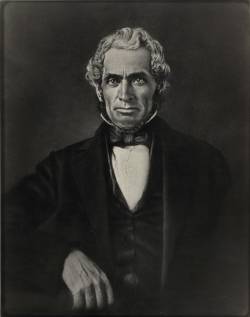
George Whitefield Potter 1806-1876 |
When I was a young man there were five living generations ! I lived near the Loyalsock during the Second World War while my father served in the Air Force. I also spent the three months of summer vacation in Bernice and on Sugar Hill. We had no running water at the Hatton home, so I went to the Loyalsock Creek to wash and later shave as I grew older. It was very cold in the Winter months but I preferred it to washing at home. We had two wood stoves in the home of my Hatton grandparents, one in the living room and a second in the parlour. The second stove was a pot bellied stove and few hours were spent outside the kitchen. That is where we spent most of the Winter months except for Christmas. |
The Potter farm had became the Exley farm when my great-grandmother married Henry Charles Exley. The farm is still in the family and now the lane leading to the farm has a road sign " Exley Lane." My mother once told me that the song "Winter Wonderland "was written about that lane. All that I can find indicates that that is true. The Exley farm had running water, but was also heated by wood and coal burning stoves. Today all the convenieces are there. However, the people have not changed much. George Gilbert Potter's brother, Daniel Wellington Potter, lived on a nearby farm. The letters written, that are still preserved, during the Civil War are from George to Daniel. Cordelia, a sister, had married Rudolphus Alger. One family lost all four sons during te Civil War. |
My GGG-Grandfather pictured here was a cousin of Orlando Bronson Potter who wrote the first National Banking Act and knew President Lincoln and Secretary Chase. Other Bliss family relatives moved to N.Y.C. from Fly Creek and prospered in that City. |
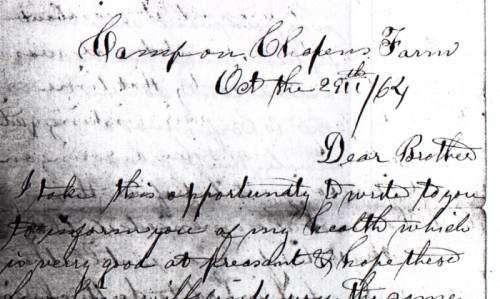
Small sample of the original letter written by George Gilbert Potter to his brother Daniel Wellington Potter during the Civil War. |
Many of the families are descended from Mayflower Passengers as well. |
To Author |
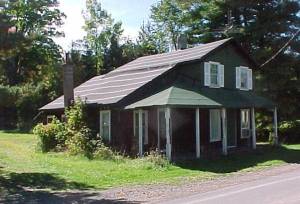
Home of Charles William Hatton, son of Charles who helped build Trinity Lutheran Church. The home is used for hunting now. When I was a boy the yard was full of flower beds and a tire swing hung from the Beechnut tree, a seed from the Forest of Dean in England.This is a coal miner's home and though it was only expected to last 10-15 years, it is over 90 years old. In the early days there was a barbed wire fence along the front to keep the cows from coming into the yard as they were brought from the pasture. An out house stood about 30 feet from the back of the house. The first window on the second floor was the bedroom of my brother and I. Our Hatton family lost three members in mine accidents. My Great-Grandfather, a great-uncle and finally my grandfather from black lung. My grandfather educated all of his children and the lives of our children are quite different. |
To turn the music off just click on the square button. |
To turn the music off just go to the bottom of the page. |
Lawi-Saquick begins in Wyoming County and ends at Montoursville PA where it empties into the Susquehanna River. Forksville is in Sullivan County. A beautiful old covered bridge crosses the Loyalsock. My GGG-Grandparents are buried not far from there. The Loyalsock was our recreation. It wasn't until I was in my twenties that I was told the story of our family and many others in the area. It all began in America in 1635, not mentioning my Mayflower roots. But this is not about one family. It is about many early families. |
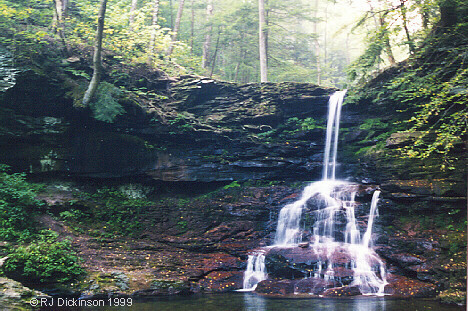
Just one Waterfall at Ricketts Glenn Permission granted by R.J. Dickinson. Robert Ricketts bought his first store in Forkville . |
To summarize, "Lawi-SaQuick", as I refer to the Loyalsock Creek, is the end of the journey. I have written a story that begins in England a few years before the various families depart for America. New families and characters continue to enter into the story. The thread that holds it all together is the journey of my family and a few others who followed the same path or, at least, shared many years. It's a story that will affect the lives of millions of Americans who have never identified with our history simply because no mention has been given to what I call , ' the bit players". I think a nation fails when the people cannot indentify with it's history and we simply cannot find that most important bond. I felt this is a story that must be told for the sake of our children, our descendants, a book for school children. Perhaps a book tht ought to be placed in the libraries of this nation a book about the people. A book of, by, and for the people. It is upon the lives of the untold millions that we owe the greatness of this nation. We cannot expect to find pride when one cannot find something to be proud of, and a nation cannot stand solely on the shoulders of a few who have been exalted far beyond their true character. It's time to share the story. It's time to tell about the farmer who farmed and fought. Of his life, his family and his journeys. The charater of America is complex and ever changing, yet somehow eep in the American soul there still lies this wonderful spirit wiling to sacrifice as in the tragedy of September 11, 2002. Shortly after that day I returned to the Loyalsock. My wife and I though apprehensive felt that we needed to go home. It was October and in the moutains the leaves had begun to change. The weather was beautiful. We landed in Philadelphia, rented a car and began our 3 1/2 hour trip to the Ponono Mts. to my father's home. It was from there that we would then continue to the Loyalsock. Along the way we saw flags hanging from almost every barn, house and business as we drove through the small towns and villages. My wife commented that we ought to come back! I knew I could never again go home. It was sad in a way, but my life had changed with decisions made by a young man who didn't understand how important home was. My wife whose family settled within walking distance from mine in 1639 had never seen the Loyalsock. We had been in the general area but never made the trip to where I swan as a boy, or to the covered bridge or the place where my ancestors where buried. We stopped at the Exley farm and gathered a few more old photographs and talked about a biography written in 1849. My cousin, Robert Exley and wife Joan, took us up to the original farm house where everything remained as it did upon the death od Robert's father. We sorted through old photographs looking for one of an Indian Maiden who we have not fully indentified. Bob mentioned that my brother was bow hunting and staying in the old Hatton House. About a week before a huge section of one of the barns had been ripped out by a bear who somehow smelled the old crates that once held honey. He had torn out about 10 feet of the side of the building. Across from the barn was "Hatton's Woods" once "Hatton's Field". The Potters had used the land, with permission of our early family, for farming. There has always been one missing piece in our history. In a cemetery at Peace Church is buried August Oechsley/Oechsle. This was the father of Henry Exley. We know little about him. I many ways it was a sad time. They were all gone. The voices I heard so many times as a boy. I could only feel the fading spirits knowing I was now the old man, the next generation to leave. I felt I needed to say something, to leave something more than material things, something important. I knew that I was the oldest of 38 grandchildren and few, if any, knew our story. Remembering the times I asked questions of both my great-grandparents and I made little notes and had a box full of family genealogy and photographs. With that I started on our story. A story that represents so many Americans. I felt this is what I should do and it was sorely needed. What better gift to leave than a living , although not alive, family history with the thoughts, experiences, tragedies, and successes. We were not always poor, nor always wealthy. We farmed, mined coal, and with the help of God designed Subways, built huge buildings, wrote, and so much more. We were and still remain an American family. It is not possible for me not to meet a farmer, a miner, a corporate executive and not be able to identify with all. However, there are only two places where my heart will remain, the Loyalsock Creek and Shady Nook. Shady Nook was a place on Marshall's Creek. The family had a log cabin on the creek and there was an area near the cabin that we called " Shady Nook". Family members went there to think or pray. The creek was full of trout and not very deep. There was a small bench there and the trees covered the creek. I never knew there had been another "Shady Nook" in our past history. It was not far from Otsego County, N.Y. and Sullivan County, PA. Deacon Daniel Potter's Congreagational Church had burned down in Old Hartwick, N.Y. but the wood that could be salvaged was used to build a home which still stands until this day. My cousin Ronald Potter had filmed the area. He had taken a trip with our cousin Robert Exley in the spring of 2001. I am not an author, perhaps not even very good at expressing my thoughts, but this is an attempt to do something I never did before for the sole purpose of giving something to the people and especially the chidren of this nation. It's what I want to leave behind. Perhaps only my decendants will care and perhaps they won't. I do know that in every generation there are those that do care. In that case I leave it to them. "Lawi-Saquick" was written and compiled to be a gift. It was not meant to be a commerical venture. My hope is that someone, somewhere, who has the ability to present this story in a meaningful way will do so. I can only long for the days past when I swan, then shaved in the Lawi-Saquick. Times of voices now gone and the laughter of family members now past, perhaps leaving this task to me. The vegatable garden, the chickens, the family reunions, the terrible sound of the siren when a mining accident occurred. My grandfather who could not walk more than 15 feet without stopping and gasping for breath. The day my father took me into the mines and asked , "Is this what you want?" My uncle later built a factory, which my father designed, in the area. There were the great homes in Philadelphia and the good times that came with success. Others remained forever on Sugar Hill and on the farm. And, because of them we can go back even if it is only for a brief time. That day will end someday soon. So, I leave this story so that others can relive and perhaps think carefully about the paths they take in life. I don't know what success really is, I do know what love is because we had plenty of that. I remember the Thanksgivings, Christmas midnight serice and my aunt laying Christmas Carols as we huddled near the pot bellied stove. I know what hard work is, why laughter is important and love essential. Sometimes it may be more rewarding to stay home. |
This Site is was designed for the purpose of finding a Publisher.The author can be contacted by E-mail. |
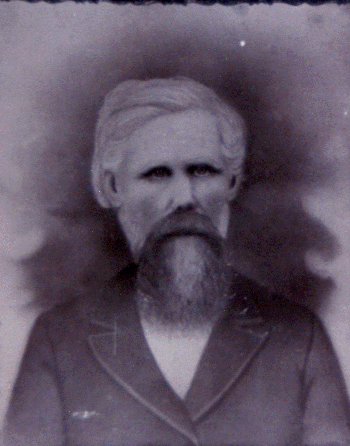
George Gilbert Potter. Just before he died. Civil War Veteran |

C.J.Hatton, working in the mines at 12 years old |
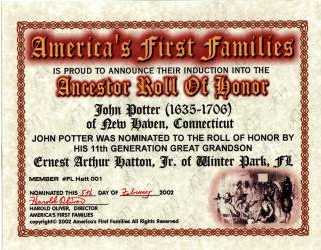
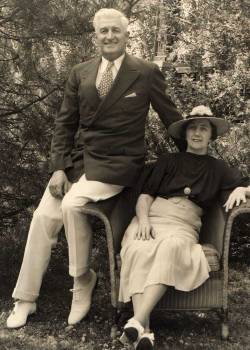
My grandfather left the farm and enjoyed success, but returned often |

Names: Potter, Bliss, Rowley, Munson, Hinman, Wood, Holt, Woodruff, Younglove, Hatton, Hoyt, Pease and " Many" others. |
The "Guest Book" is also for comments. Please remember,.. this is not the book, but an introduction to the reason for writing the book and a general summary as to what the work is about. It is also an introduction of "few "characters. |

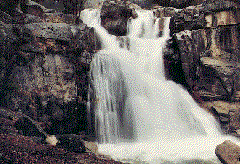
Forever flowing. |
or, choose the Site, They are in various stages of completion. |


